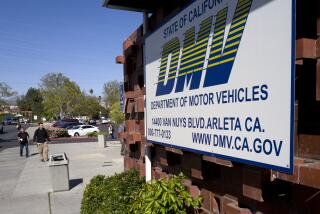How to Steer Your Way to a Passing Grade
- Share via
You’ve paid the $10 application fee. You’ve passed the written exam and vision test. Now you’re sitting in your car waiting to take the State of California Department of Motor Vehicles’ Road Test.
Here are a few points to ponder before the clipboard-toting examiner slides into the passenger seat:
Applicants begin with 100 points at the start of the drive test, and points--anywhere from one to six per maneuver--are taken off for each driving error. To join the ranks of California’s more than 17 million licensed drivers, you must score at least 70 to pass.
A Word of Warning
But, as the state duly warns on the official Road Test Score Sheet, “failure on any maneuver is grounds for immediate ending of the test.”
So be careful not to run a red light or a stop sign. Don’t violate a pedestrian’s right of way in a cross walk. Be sure you don’t drive too fast--or too slow. And don’t make an unsafe turn into oncoming traffic.
Those are just a few of the more common causes for immediate failure, according to Gilbert von Studnitz, drivers license manager at the department’s Los Angeles metro office.
“What we’re basically looking for are people that are safe drivers,” Von Studnitz said. “We’re not going out there looking to fail them just because they make a few technical mistakes. We want them to pass as long as they’re safe drivers.”
Vehicle Safety Check
Before applicants are put through their paces, the examiner will conduct a pre-trip inspection--to make sure the brake lights and turn signals operate properly, that the car has seat belts and a horn and, in general, to see if the vehicle is safe to operate on the streets. Von Studnitz says an applicant with a car that has “gross defects” such as bald tires or no fuel-tank cap will not be allowed to proceed to the next phase of the test: the road test.
During the 10- to 15-minute road test, applicants must demonstrate their knowledge of such skills as backing and doing a turnabout, or wide turn. They’re also graded on such basic driving skills as how cautious they are at intersections and in changing lanes, whether they obey stop signs and traffic signals, how well they make right and left turns, whether they yield the right of way to other vehicles and pedestrians, how well they control the speed of the vehicle, and how well they change lanes and react to hazards.
But should you fail the first time out, all’s not lost. For the same $10 fee, you get three cracks at both the written exam and the drive test.
Although about one-fourth of all applicants fail the first time around, Von Studnitz said most pass on the second try and “an overwhelming majority will have passed by the third time.”
He added, however, that there is also “a teensy minority” that apply repeatedly “and they’re the ones that make the most unusual stories.”
More to Read
Sign up for Essential California
The most important California stories and recommendations in your inbox every morning.
You may occasionally receive promotional content from the Los Angeles Times.









